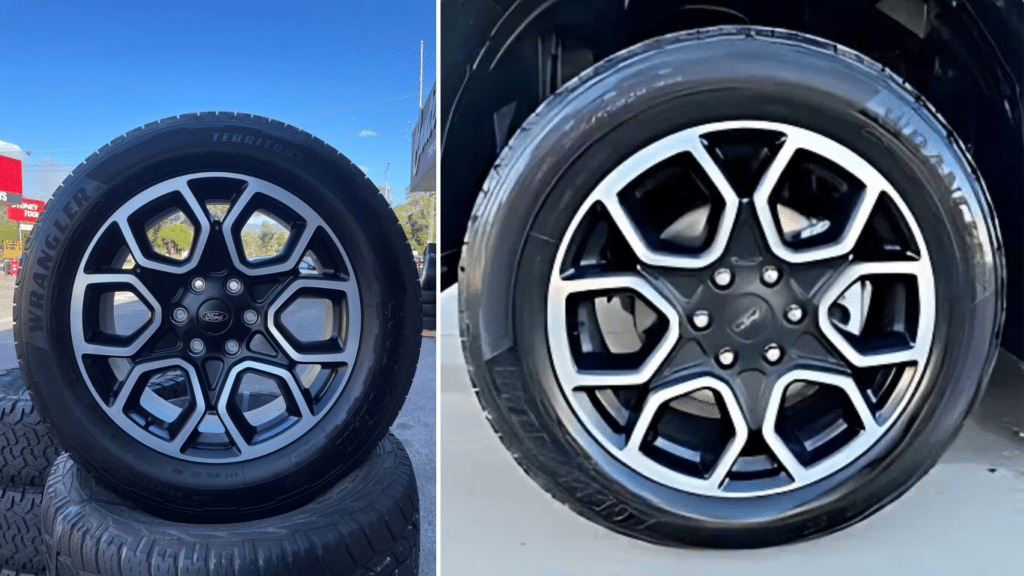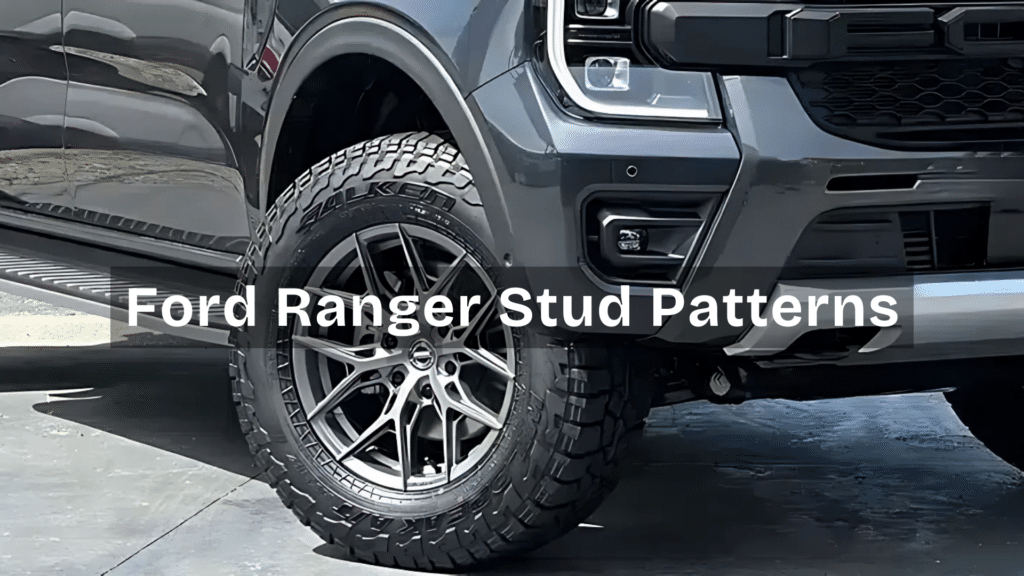Knowing the stud pattern is super important if you’re considering upgrading or replacing the wheels on your Ford Ranger.
The stud pattern, also called the lug pattern, tells you how many bolts hold your wheels in place and how far apart they are. If the pattern doesn’t match, the wheels won’t fit properly.
Most Ford Rangers use a 6×139.7mm (6×5.5″) stud pattern, but older models may have different patterns. That’s why it’s always a good idea to check your specific model year before buying new wheels.
In this blog, I’ll explain the Ford Ranger’s stud pattern, how to measure it, and why it matters. I’ll also share some tips to help you choose the right wheels.
What is a Stud Pattern?

The stud pattern (or lug pattern) refers to how the wheel bolts (or lug nuts) are arranged on the wheel hub. It has two parts:
- Number of bolts (or studs): This tells you how many bolts hold the wheel in place.
- Bolt circle diameter (BCD): The distance between the bolts is usually measured in millimeters (mm) or inches.
For example, a 6×139.7mm (6×5.5″) stud pattern means that 6 bolts hold the wheel in place. And 139.7mm (or 5.5 inches) is the circle’s diameter formed by these bolts.
Getting the correct stud pattern is crucial for safety and proper wheel fitment. If you try to install wheels with the wrong pattern, they won’t line up correctly, and your truck won’t be safe to drive.
Ford Ranger Stud Patterns
Ford Rangers have used different stud patterns over the years. These are the most common ones:
1. Older Ford Rangers (Pre-2011 Models)
If you own a Ford Ranger made before 2011, it likely has a 5×114.3mm (5×4.5″) stud pattern. This means:
- The wheels are attached using five lug nuts.
- The distance across the center of the lug circle is 114.3mm (4.5 inches).
This 5-lug pattern was standard on many compact trucks, including earlier Ranger models. It was commonly used in the 1990s and early 2000s before Ford transitioned to a 6-lug design in later years.
2. 2011-Present Ford Rangers
Starting in 2011, Ford made a major change to the Ranger’s wheel design by switching to a 6-lug pattern. This means most modern Ford Rangers (2011 and newer) now use a 6×139.7mm (6×5.5″) stud pattern, which includes:
- 6 lug nuts securing the wheel.
- A 139.7mm (5.5 inches) bolt circle diameter.
This 6-lug pattern is more common on midsize and full-size trucks, offering better strength and durability, especially for off-road and heavy-duty use. It also allows for a wider selection of wheel options, as many truck wheels use this pattern.
3. Special Editions and Regional Differences
While most North American Ford Rangers (2011-Present) use the 6×139.7mm pattern, there are some exceptions based on:
- International models: Some Ford Rangers outside the U.S. and Canada may have slightly different stud patterns, depending on local market requirements.
- Limited editions: Some special models or trims have different factory wheels requiring unique specifications.
How to Measure a Stud Pattern
If you’re unsure about your Ranger’s stud pattern, you can measure it yourself in a few simple steps.
- Count the number of bolts: This is the first number in the stud pattern. Most Rangers will have either 5 or 6 bolts.
- Measure the bolt circle diameter (BCD):
- If you have an even number of bolts (like 6), measure from the center of one bolt to the center of the bolt directly across from it.
- If you have an odd number of bolts (like 5), measure from the center of one bolt to the imaginary circle that runs through the other bolts.
- Convert to millimeters or inches: Many manufacturers list stud patterns in both mm and inches, so check which measurement is used.
Once you have both numbers, you will know your stud pattern and be able to find wheels that match!
Why the Stud Pattern Matters
Getting the right stud pattern for your Ford Ranger is more than just about making the wheels fit—it directly affects your truck’s safety, handling, and durability.
Choosing the wrong stud pattern can lead to serious problems, from wobbling wheels to potential accidents on the road. Here’s why it’s so important to match your wheels to the correct stud pattern.
1. Ensures Proper Fit
The stud pattern determines whether a wheel properly attaches to your Ranger’s hub. If the pattern doesn’t match, the holes in the wheel won’t line up with the lug bolts, meaning the wheel won’t fit.
Even if the pattern seems close, forcing the wheel onto the hub can cause serious issues, such as damaged wheel studs and uneven pressure, and create unsafe driving conditions.
2. Keeps Your Truck Safe
Your wheels are one of the most important safety features on your truck. They hold the vehicle’s weight, support braking, and provide traction on the road. You could run into serious safety risks if your wheels don’t fit properly.
Some dangers of an incorrect stud pattern include wobbling wheels and wheel detachment. A properly matched stud pattern provides smooth steering and handling.
3. Prevents Expensive Mistakes
Nobody wants to spend money on new wheels only to realize they don’t fit. Getting the wrong stud pattern can lead to wasted time, hassle, and extra costs.
Double-checking your Ford Ranger’s stud pattern before buying wheels saves you from frustration, money, and potential safety issues.
Whether you’re replacing old wheels or upgrading to a new set, always make sure they match your Ranger’s exact stud pattern.
Choosing the Right Wheels for Your Ford Ranger
If you’re looking for new wheels, here’s what you need to consider:
1. Check the Stud Pattern
- For most modern Ford Rangers, the stud pattern is 6×139.7mm (6×5.5″).
- If your truck is older than 2011, it might have a 5×114.3mm (5×4.5″) pattern.
- Double-check your manual, manufacturer specs, or measure it yourself.
2. Consider Wheel Size and Offset
- Wheel diameter and width should match or be close to factory specs unless you’re doing a custom build.
- Offset and backspacing affect how far the wheels sit inside or outside the fender.
3. Material
- Steel wheels are heavier but stronger—great for off-road use.
- Aluminum alloy wheels are lighter and improve fuel efficiency but may not be as tough.
Common Mistakes to Avoid
- Buying wheels with the wrong stud pattern: Always check the specs before purchasing.
- Ignoring offset and backspacing: The wrong offset can cause rubbing issues.
- Not checking tire compatibility: Some wheels may require different tire sizes.
- Forgetting about wheel adapters: Some people use adapters to change the stud pattern, but this isn’t always safe.
Conclusion
Knowing your Ford Ranger’s stud pattern is key to finding the right wheels. Most modern Ford Rangers (2011 and newer) use a 6×139.7mm (6×5.5″) pattern, while older models may have a 5×114.3mm (5×4.5″) pattern.
Before buying new wheels, always double-check your truck’s specs, measure the stud pattern if needed, and consider other factors like size, offset, and material.
Taking the time to get the right fit will save you from wasted money, returns, and safety risks. With the right wheels, your Ranger will not only look great but also handle smoothly and safely!
Frequently Asked Questions
Do all Ford Rangers have the same stud pattern?
No. Older models (pre-2011) often have a 5×114.3mm (5×4.5″) pattern, while 2011 and newer models typically use 6×139.7mm (6×5.5″). Some international or special edition models may differ.
Why did Ford switch to a 6-lug pattern?
Ford switched to a 6×139.7mm pattern for better durability, off-road capability, and compatibility with larger tires. The 6-lug design provides stronger load support and better wheel security.
Are Ford Ranger and Ford F-150 wheels interchangeable?
No, the F-150 uses a 6x135mm stud pattern, which is different from the Ranger’s 6×139.7mm pattern. The bolt holes won’t align, making the wheels incompatible without adapters.
How do I find my Ford Ranger’s stud pattern without measuring?
Check your owner’s manual, look at the door jamb sticker, or search online using your model year and trim to find the correct stud pattern.
What happens if I use the wrong stud pattern?
Using the wrong stud pattern means the wheels won’t fit or tighten properly, leading to vibration, instability, and potential wheel detachment, which is dangerous.


